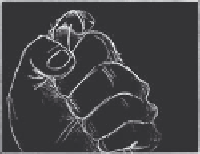Graphics Reference
In-Depth Information
with their costuming similarly naturalistic. Because the puppets had to stand on the revolving
set, the size of which was dictated by the length of my arms, the puppets ended up being
smaller than preferable. The mechanics involved with the revolving stage meant I could not
place magnets under the actual l oor surface, so tiny magnets were disguised in the soles of
the shoes. This was less than perfect as the magnets were not strong enough to support the
puppets, and I could not switch of the magnetism. I was unable then to give the nice peeling-
of shape to the feet as they walked, and they all look a bit l at-footed. The small scale of the
puppets meant that armatured hands were out of the question (and budget) and their hands
had wires in the i ngers; after such intense use, these got a bit mangled. Happily, the Recitor
(the narrator) was slightly larger, with a pair of beautifully armatured hands. I'm wondering now
whether these weren't borrowed from the Shakespeare puppet. Owing to the sign language
the Recitor performed, he had to have very articulate hands. The costume was designed
around how the character would perform. With the hands being so signii cant, and most of the
i lm in wide shot, we had to make sure they were clearly visible, so they were very white and
stood out against a dark blue costume. Nigel Cornford, the designer, had originally pictured a
paler top for his costume, but I was worried that the hands would have got lost against this.
That
Screen Play
is seen as successful still
surprises me. I worried it might have been
an enjoyable but indulgent exercise on my
behalf. That people are moved by it and
watch it frequently, and that it is studied in
colleges, is a constant source of unexpected
pleasure. There were many reasons for
wanting to make it, and most of them to do
with interesting storytelling, but now I feel
there is too much storytelling and no actual
story. I would love to revisit it. Another
reason for the i lm was the long, extended
shot, as this was the nearest I could get to
the adrenaline of performing.
Stop motion is unlike any other
performance. Once you've done a shot, you
suddenly think of another piece of business,
or a dif erent way to have timed it, but you
cannot go back. This is both terrifying and hugely exciting, even today after thirty years.
Screen
Play
was that recurring dream I mentioned earlier. As I took that i rst frame, that was it for
nine and a half weeks of shooting. That extended period of adrenaline plays with your head,
but what an exciting challenge. Whether this was for my seli sh benei t, I don't know, but the
audience seems to enjoy the constant and lyrical stream of changing imagery. It would not
have worked if I had used close-ups, and there would not have been the shock
when the i lm starts to use cinematic grammar. As the title implies, it was all about
playing with storytelling … and screens. The i rst section is a theatrical piece, with
the audience, given only one objective viewpoint, being told where to look by
lighting, staging, design and the movement of the revolving stage. The second
section uses seemingly more naturalistic i lmic elements of close-ups, moving
cameras, and so on, to guide an audience. This is a bit of a cheat, and probably why
The Recitor's storytelling hands from
Screen
Play
and that blood again.



Search WWH ::

Custom Search